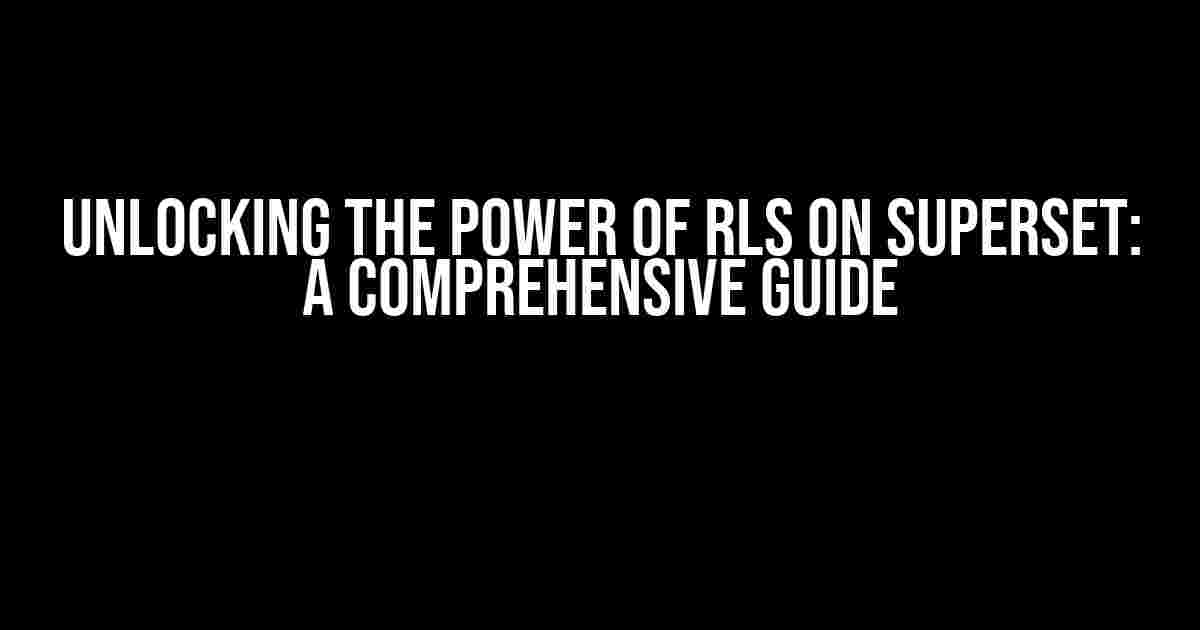Are you tired of dealing with slow and inefficient data analytics? Do you want to take your data visualization to the next level? Look no further! In this article, we’ll dive into the world of RLS on Superset, a game-changing technology that’s revolutionizing the way we work with data.
What is RLS on Superset?
RLS stands for Row-Level Security, a feature that allows you to control access to your data at the row level. Superset is a popular open-source data visualization platform that enables users to create interactive dashboards and reports. When you combine RLS with Superset, you get a powerful tool that not only secures your data but also enhances your analytics capabilities.
How Does RLS on Superset Work?
RLS on Superset works by allowing you to create fine-grained access controls for your data. This means you can specify which users can view or edit specific rows of data, ensuring that sensitive information remains confidential. Here’s an example of how it works:
# Define a role-based access control (RBAC) policy
rbac_policy = [
{
'username': 'alice',
'permissions': ['view'],
'row_filter': '(department = "marketing")'
},
{
'username': 'bob',
'permissions': ['edit'],
'row_filter': '(department = "sales")'
}
]
# Apply the RBAC policy to your Superset dashboard
superset_dashboard.apply_rbac(rbac_policy)
In this example, we define a RBAC policy that grants Alice view-only access to rows where the department is “marketing”, and grants Bob edit access to rows where the department is “sales”. We then apply this policy to our Superset dashboard, ensuring that each user sees only the data they’re authorized to access.
Benefits of RLS on Superset
So why should you care about RLS on Superset? Here are just a few benefits:
- Enhanced Security**: RLS on Superset ensures that your data is protected from unauthorized access, reducing the risk of data breaches and leaks.
- Improved Collaboration**: With fine-grained access controls, you can collaborate with team members and stakeholders without worrying about data confidentiality.
- Faster Insights**: RLS on Superset enables you to create targeted dashboards and reports that cater to specific user needs, leading to faster insights and better decision-making.
Setting Up RLS on Superset
Ready to get started with RLS on Superset? Here’s a step-by-step guide to setting it up:
- Install Superset**: First, you’ll need to install Superset on your machine. You can do this by running the following command:
- Configure Superset**: Next, you’ll need to configure Superset to connect to your database. You can do this by creating a
superset_config.pyfile with the following content: - Define Your RBAC Policy**: Create a Python script that defines your RBAC policy using the
superset.securitymodule: - Apply the RBAC Policy**: Finally, apply the RBAC policy to your Superset dashboard by running the following command:
pip install superset
SQLALCHEMY_DATABASE_URI = 'postgresql://username:password@localhost/dbname'
from superset.security import rbac
rbac_policy = [
# Define your RBAC policy here
]
superset_dashboard.apply_rbac(rbac_policy)
superset db upgrade
Best Practices for Implementing RLS on Superset
Here are some best practices to keep in mind when implementing RLS on Superset:
| Best Practice | Description |
|---|---|
| Keep Your RBAC Policy Simple | Avoid complex RBAC policies that are difficult to maintain and debug. Instead, focus on simple, easy-to-understand policies that cater to specific user needs. |
| Use Row-Level Filtering | Use row-level filtering to restrict access to sensitive data. This ensures that users only see the data they’re authorized to access. |
| Implement Least Privilege Access | Grant users the minimum level of access required to perform their tasks. This reduces the risk of data breaches and leaks. |
| Monitor and Audit Access | Regularly monitor and audit access to your data to detect and respond to potential security threats. |
Common Challenges and Solutions
Implementing RLS on Superset can come with its fair share of challenges. Here are some common issues and solutions:
Challenge: Performance Issues
Solution: Optimize your database queries and indexing to improve performance. You can also use caching and other optimizations to reduce the load on your database.
Challenge: Complex RBAC Policies
Solution: Break down complex RBAC policies into simpler, more manageable components. Use inheritance and role-based access to simplify your policy definitions.
Challenge: User Adoption
Solution: Provide comprehensive training and documentation to help users understand how RLS on Superset works. Make sure to communicate the benefits and value of RLS to your users.
Conclusion
In conclusion, RLS on Superset is a powerful tool that can revolutionize the way you work with data. By implementing RLS, you can enhance security, improve collaboration, and gain faster insights into your data. Remember to follow best practices, monitor and audit access, and provide comprehensive training to your users. With RLS on Superset, you can unlock the full potential of your data and take your analytics to the next level.
Remember to bookmark this article and share it with your friends and colleagues who are interested in RLS on Superset. Happy analytics!
Frequently Asked Question
Got questions about RLS on Superset? We’ve got you covered! Here are some frequently asked questions and answers to help you get started.
What is RLS on Superset?
RLS (Row-Level Security) on Superset is a feature that allows you to restrict data access to specific users or groups based on their roles or permissions. It enables you to define custom permissions and access controls for your data, ensuring that sensitive information is protected and only accessible to authorized users.
How does RLS on Superset work?
RLS on Superset works by evaluating a set of rules against each user’s credentials and permissions when they attempt to access a dataset. These rules are defined by administrators and can be based on various factors, such as the user’s role, department, or location. If the user meets the conditions specified in the rule, they are granted access to the data; otherwise, access is denied.
What are the benefits of using RLS on Superset?
Using RLS on Superset provides several benefits, including improved data security, reduced risk of data breaches, and increased compliance with regulations. It also enables organizations to implement fine-grained access controls, ensuring that users only have access to the data they need to perform their jobs.
Can I implement RLS on Superset for multiple datasets?
Yes, you can implement RLS on Superset for multiple datasets. In fact, Superset’s RLS feature is designed to work across multiple datasets, allowing you to define access controls and permissions at the dataset level, or even at the individual column or row level.
Is RLS on Superset compatible with other security features?
Yes, RLS on Superset is designed to work seamlessly with other security features, such as authentication and authorization, encryption, and auditing. This ensures that your data is protected by a robust and multi-layered security framework.


